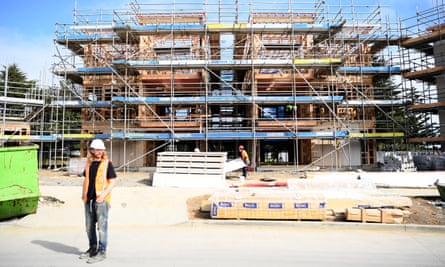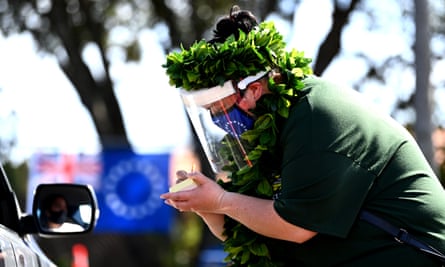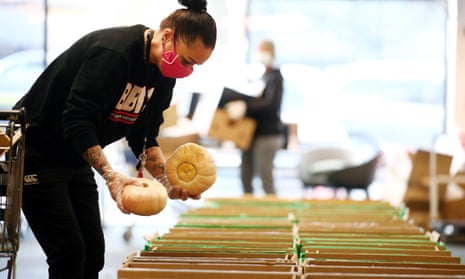Like clay pressed into a mould, Covid outbreaks tend to conform to the contours of a country’s existing inequalities and cracks, replicating them over again.
Social scientists have called the pandemic a “threat multiplier”, taking existing social problems, and compounding their force. In New Zealand, the country’s growing Delta outbreak is now interweaving with longstanding housing affordability crisis and racial inequalities. As the government continues to loosen restrictions, experts say a growing outbreak will make those divides more and more pronounced.
“Right now we have got a crisis which is the duality of the housing crisis and the Covid crisis,” says Dr Rawiri Jansen, clinical director of the Hauora Coalition, an equity-focused Māori health provider, and co-leader of Te Rōpū Whaka-kaupapa Urutā, a Covid health advice provider for Māori.
The outbreak in Auckland, previously contained by tough level four lockdown measures, began to spread as some of those restrictions were lifted. Tentacles of infections unfurled through the country’s emergency and temporary housing. Fifty new cases were reported over the weekend, including several outside Auckland, and another 29 on Monday. The outbreak so far has established itself along stark ethnic lines: about 83% of infections in the current outbreak are Māori and Pacific New Zealanders, who only make up about 27% of the total population combined.
A predictable crisis
It’s a disaster the New Zealand government knew was on the horizon. “Once the virus gets out and starts spreading, if you struggle to contain it, which they clearly are, it will find the most vulnerable communities, and once it makes its way into those communities it’s really hard to stop it,” Covid response minister Chris Hipkins told the Guardian in September, discussing lessons learned from Australia. “In Australia, it is making its way into the poorest, least vaccinated, highest health needs communities, and having a massive impact on them.”

Jansen has been working on the frontlines of Māori health provision for years, and his frustration is audible. He said the current crisis the government faces was entirely predictable.
“Even in our public position of having hundreds of days without bloody Covid, we still weren’t ready,” he said. “Come on, wake up, everybody knows there’s a housing crisis, it’s been going on for fucking five years – we’ve been trying to manage patients in primary care telling us they’re living in cars. And so when Covid came along, we had this well-known health crisis called housing,” he said.
Many of those affected have spent years living in precarity, Jansen said. Now, they have every reason to be suspicious of the officials tasked with convincing them to get vaccinated, isolate, or adhere to other public health guidelines.
“Those communities … have been made vulnerable by our failure to address the housing crisis. Our failure to address poverty. And now, as Covid gets in there, it’s a very, very difficult place for us to be able to manage,” he said.
“We’re refusing to see, refusing to hear, we’re refusing to speak out about it – and we’re fuckwits if we do that.
“It’s a kind of perfect storm for vulnerable groups,” says Prof Michael Baker, an epidemiologist and public health professor. “Because you’re more likely to have long-term [health] conditions, you’re often living in more crowded conditions, all the other things that go with poverty. And then you get an infectious disease thrown into the mix like Covid-19, and it’s absolutely devastating,” he says. “These are sometimes multiplicative effects – they’re not just additive.”
‘The failure to get equity right’
In public health and anthropology, they call these “syndemics” – a combination of the words “synchronised”, or “symbiotic” and “epidemic”. “It’s the idea of epidemics that occur together, and they increase each other,” he says.
The term was initially developed to describe how tuberculosis and Aids epidemics merged and snowballed – tuberculosis can lie latent in a host, but combined with an Aids infection, it’s disastrous. But an epidemic of literal disease can also interweave with epidemics that are social and environmental – of inequality, or of racism, or of housing unaffordability. Those kinds of social problems tend to manifest as disease too: people living in social deprivation have higher rates of asthma, diabetes, obesity, cardiovascular illness – all risk factors for serious illness or death from Covid-19. When added together, those factors can become more than the sum of their parts.

“Infectious diseases are one of the strongest markers of inequality,” Baker said. That’s not just true of Covid – other epidemic diseases, like the flu, also distribute themselves along socio-economic and ethnic curves.
“One of the most important themes in managing all health problems, but particularly pandemics, is getting equity right,” Baker said.
“We’re seeing now the failure to get equity right: it’s this long tail of Auckland cases amongst the most marginalised and deprived and vulnerable groups. That is actually threatening the entire pandemic response.”
The outbreak, he said, was a confronting example of how failing to protect your most vulnerable could hurt an entire country. “It’s one of the most vivid examples I’ve ever seen of why inequality matters for people who are most vulnerable, but also for all of us,” Baker said. “Even if you are in your gated community and think ‘I’m OK. I don’t need to worry about other people,’ this is a very vivid example of why we are all in it together – there’s no better example I can think of at the moment than that.”
Now, as the government eases restrictions in Auckland, there are fears the outbreak will disproportionately pummel those already at risk. Partly because their populations skew younger, Māori are vaccinated at a rate about two thirds that of Pākeha [European] New Zealanders.
The government has long been aware that a growing outbreak will have far worse consequences for lower socio-economic groups. “I’ve been acutely aware of the South Auckland community, it’s always been our concern,” Hipkins told the Guardian in September. “Whenever something’s happened around South Auckland, we have to stamp it out really quickly, because the consequences for that community could be huge, even bigger than for a different part of the community.”
Two weeks later, experts say New Zealand’s shift away from elimination will put those very communities at greater risk.
“Easing restrictions too quickly given our vaccination rates at this time, along with the adverse health impact already seen for our vulnerable in Aotearoa New Zealand, will be dire,” Dr Dianne Sika-Paotonu, an immunologist at the University of Otago, said.
“How Aotearoa New Zealand responds and treats the needs of the most vulnerable during this Covid-19 pandemic will indeed reveal our moral compass as a society and define who we are as a nation for generations to come.”
